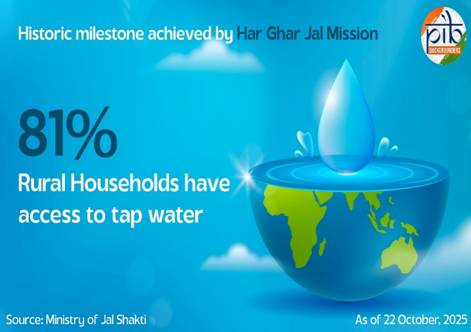In a remarkable stride towards universal water security, the Jal Jeevan Mission has provided safe tap water to over 15.72 crore rural households across India, covering more than 81 per cent of rural homes as of October 22. Launched by Prime Minister Narendra Modi on August 15, 2019, the mission has connected an additional 12.48 crore households since its inception, when only 3.23 crore households had access to tap water, marking one of the fastest infrastructure expansions in rural India. With a central outlay of ₹2.08 lakh crore, the initiative is reshaping lives by ensuring clean drinking water and fostering socio-economic development.
The mission has not only addressed water accessibility but also alleviated the centuries-old burden of water collection, particularly for women, saving an estimated 5.5 crore hours daily, with women bearing three-quarters of this load, according to the World Health Organization (WHO). The WHO also projects that universal access to safely managed drinking water could prevent nearly 4 lakh diarrheal deaths annually and avert 14 million Disability Adjusted Life Years (DALYs), yielding potential health cost savings of up to ₹8.2 lakh crore. Additionally, research by Nobel laureate Prof. Michael Kremer indicates that safe water coverage could reduce under-five mortality by nearly 30 per cent, potentially saving over 1 lakh lives each year. SBI Research highlights an 8.3 per cent decline in households fetching water from outside, freeing 9 crore women from this task and boosting their participation in agriculture and allied activities by 7.4 per cent.
The mission’s progress is evident across administrative levels. Tap water has reached all households, schools, and Anganwadi centres in 192 districts, with 116 certified by Gram Sabha resolutions. Full coverage has been reported in 1,912 blocks, 1,25,185 Gram Panchayats, and 2,66,273 villages, with certifications for 1,019 blocks, 88,875 Gram Panchayats, and 1,74,348 villages. Eleven states and Union Territories, including Goa, Haryana, Gujarat, and Arunachal Pradesh, have achieved 100 per cent tap water connectivity. Additionally, 9,23,297 schools and 9,66,876 Anganwadi centres nationwide now have tap water supply.
Quality assurance is a cornerstone of the mission, with 2,843 laboratories testing 38.78 lakh water samples in 2025-26 across 4,49,961 villages. Community participation is robust, with 24.80 lakh women trained to use Field Testing Kits in 5.07 lakh villages, ensuring early detection of contamination and fostering local ownership of water quality monitoring.
The mission emphasizes sustainability through measures like greywater management, water conservation, and rainwater harvesting. It promotes community-led governance, with Information, Education, and Communication activities driving awareness and ownership. The mission’s components include in-village piped water systems, sustainable water sources, bulk water transfer, technological interventions for water quality, retrofitting of existing schemes, and capacity building for communities.
Digital innovation is enhancing transparency and efficiency. The Department of Drinking Water and Sanitation is developing a Digital Registry for piped water schemes, assigning unique RPWSS IDs for traceability. Integrated with GIS mapping and PM Gati Shakti, this platform offers real-time dashboards and predictive analytics, empowering Panchayats and Village Water & Sanitation Committees. States and Union Territories are expected to complete RPWSS ID creation by November 2025.
The mission’s impact is vivid in community-led success stories. In Maharashtra’s Mhapan village, a women’s self-help group manages the tap water scheme, achieving 100 per cent bill collection and earning ₹1.70 lakh, making it a self-sustaining model. In Nagaland’s Wokha, communities protect water sources through recharge pits and afforestation, ensuring long-term water availability. In Assam’s Borbori village, piped water and hygiene campaigns eliminated waterborne illnesses, with cases dropping from 27 in 2022-23 to zero. Rajasthan’s Bothara village saw a 70-foot rise in water levels after implementing check dams and trenches, increasing water storage by 11.77 per cent. In West Bengal, the ‘Jal Mitra’ app has revolutionized monitoring, tracking 13.70 crore community activities and supporting 4,522 Jal Bachao Committees.














